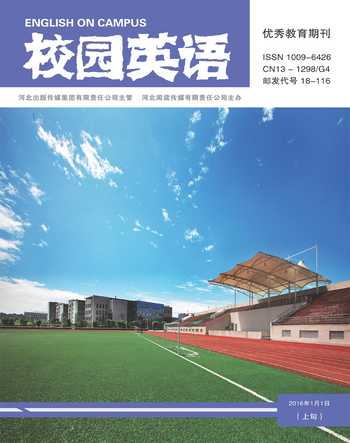A Field Study of Chinese Mingled with Foreign Words in Students’Conversations
2016-05-30JieXiaopingDongShuxin
Jie Xiaoping Dong Shuxin


【Abstract】Targeted for a preliminary study of how Chinese graduate students use different languages in their daily conversation, this preliminary project attempts to test some sociolinguistic theories on code-switching (CS). Theories concerned are mainly on two levels, linguistic features and functions of CS.
【Key words】Chinese; Foreign language; Code Switching
With Chinas frequent exchanges with foreign countries, the Chinese have been greatly influenced in their use of language in daily conversation. How people use foreign words in daily life is interesting to the linguists.
I. Literature Review
Myers-Scotton (2001) proposed the Matrix Language Framework model. The basic word structure of the matrix language determines the morphosyntax of the code-switched sentence. Wardhaugh (2000) mentions that CS is a conversational strategy used to “establish, cross or destroy group boundaries; to create, evoke or change interpersonal relations with their rights and obligations” (p. 100). Wu (1985) reports a study of code mixing by Chinese–English bilingual teachers.
II. Methodology
The sample was constituted by 10 Chinese students, altogether five conversations that last half an hour each. Four conversations were picked up while the informants were watching TV series, doing technical stuff like checking problems with computers, shopping and discussing an academic topic.
III. Research Results and Discussion
1. The Occurrence Frequency of CS.
The occurrence frequency of CS can be seen from table 1. All of the five conversations have involved CS. The following table shows the numbers and percentages of conversations with and without CS involved.
2. Linguistic Features of CS Patterns
A total of 25 instances of CS are found in the transcribed episodes. Further examination reveals that the majority of CS takes place across sentence boundaries, as shown in Table 2.
(Note: Each speakers turn, between the turns of speaking by the other person, is taken as a unit of analysis.)
The following are two examples of inter-sentential and intra-sentential CS:
(1)你那能看Friends吗? (English: Do you have Friends?)
(2)她是这样。OH… MY… GOD!太逗了!(English: She is like this. OH… MY… GOD!Just too funny!)
In example (1), the English constituents are inserted into the Putonghua matrix and the whole sentence structure is set by Putonghua. The second example is an inter-sentential CS in which Putonghua is the matrix language and English is the embedded language. The English constituent was an imitation of an actresss original utterance. The switching of noun and noun phrases in the subject or object position is predominant in the data, which is in agreement with the findings of similar studies on CS (Brice, 2000; Wu, 1985).
3. Categories of Foreign Words or Sentences Used
Foreign words found in this project include information and technology terms such as CPU, ID, E-mail, download, economic terms such as CEO, CFO, WTO, medical terms such as HIV, SARS, movie or TV names such as Friends, and others such as BF, baby, fans, faint, sign, no, happy. Foreign sentences found in the study are mainly phatic and complimentary languages such as hi, morning, see you, bye-bye, SAYONALA (Japanese for bye-bye), thanks, sorry.
References:
[1]Brice,A.(2000).Code switching and code mixing in the ESL classroom:A study of pragmatic and syntactic features.Advances in Speech Language Pathology.Journal of the Speech Pathology Association of Australia,20(1),19-28.
[2]Myers-Scotton,C.(2001).Code-switching.In F.,Coulmas (Ed.),The handbook of Sociolinguistics,pp.217-237.Beijing:Foreign Language Teaching and Research Press.
[3]Wu,Yian.(1985).Code-mixing by English-Chinese bilingual teachers of the Peoples Republic of China.World Englishes,4(3),303-317.
